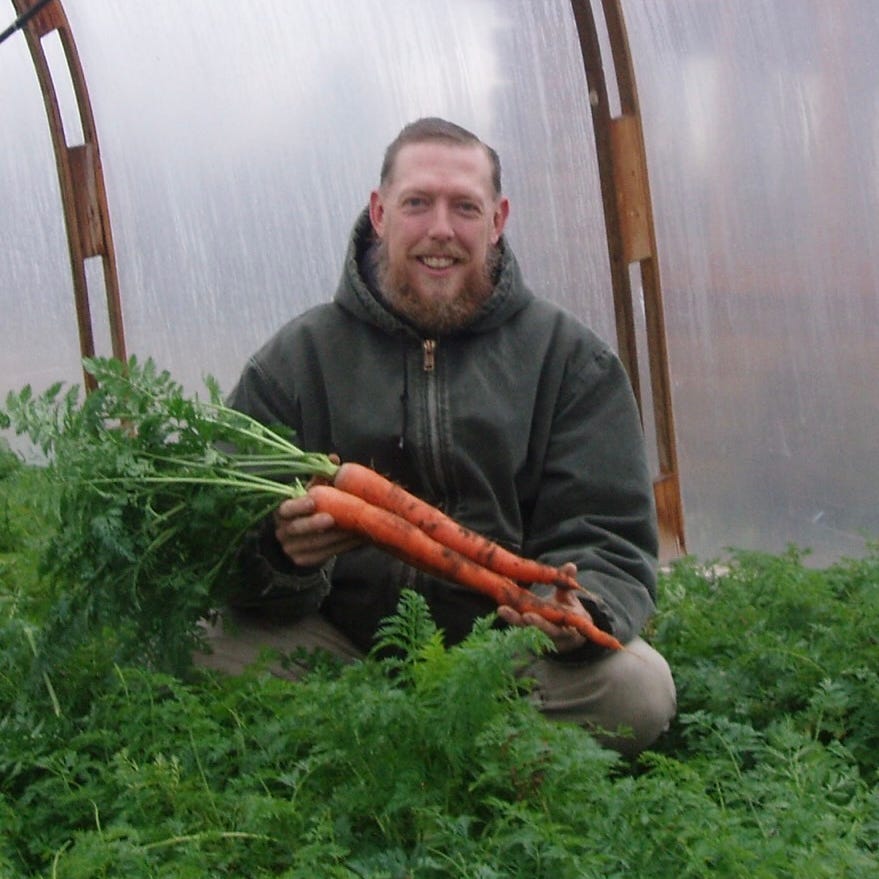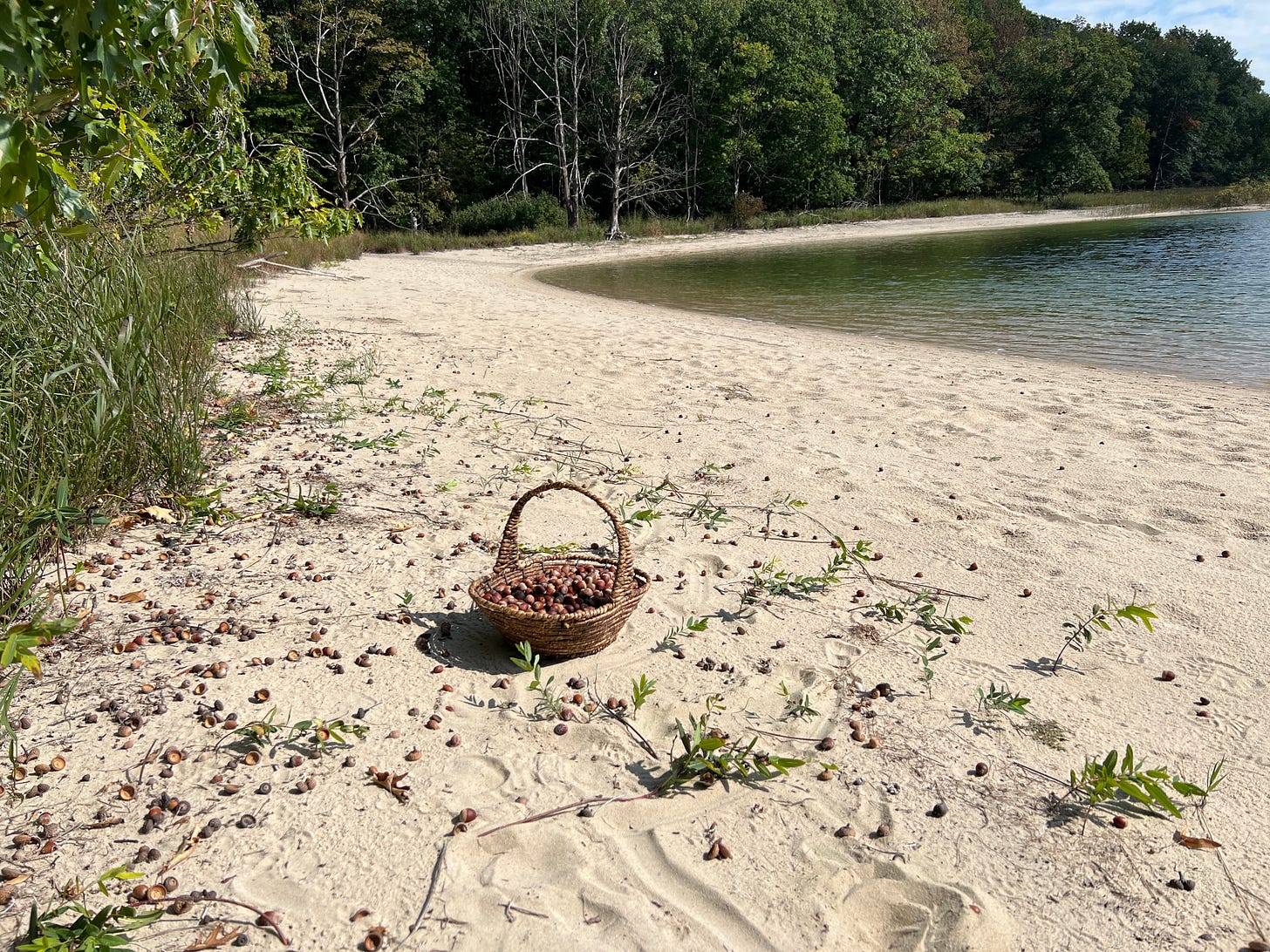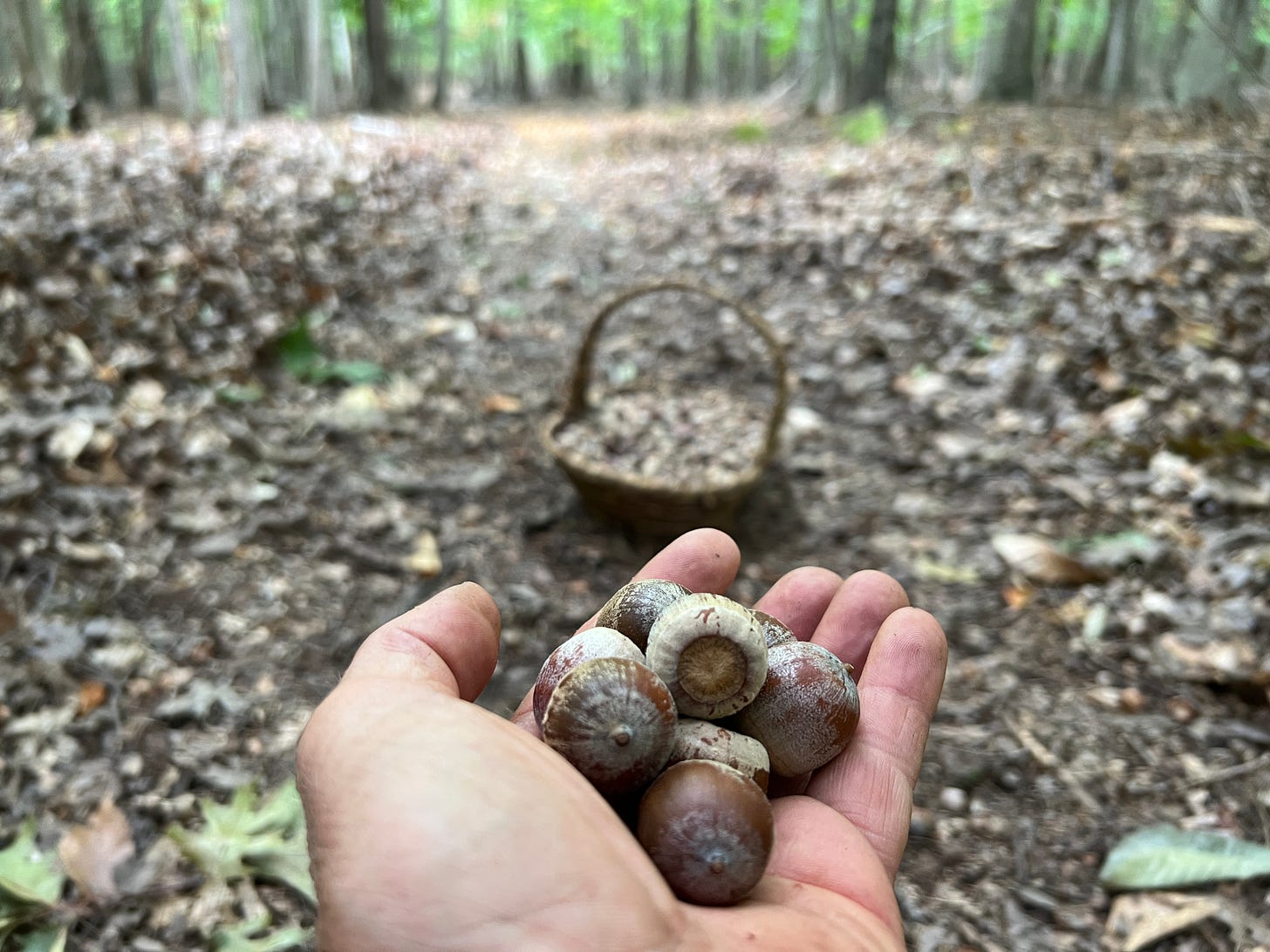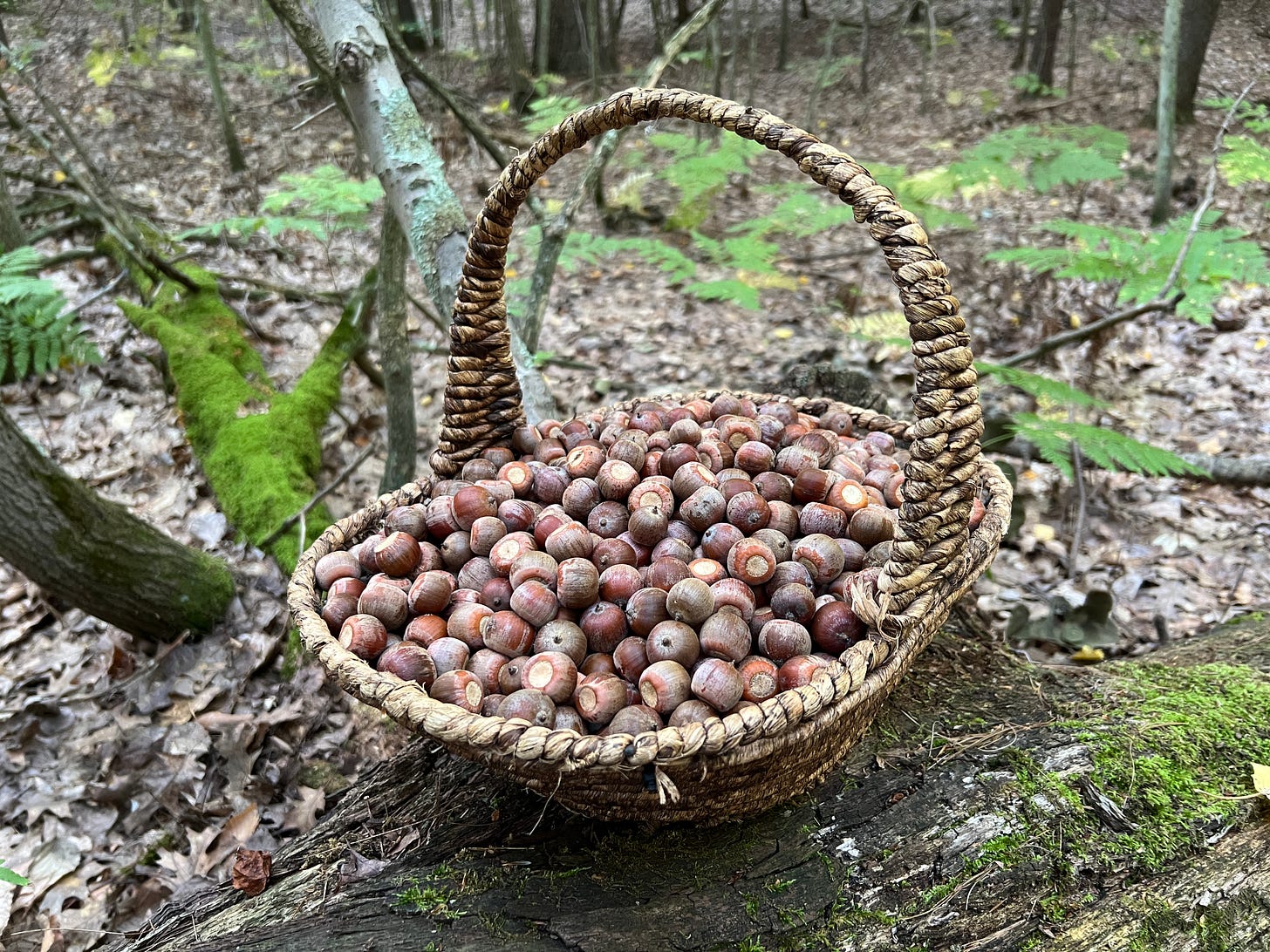October 13th, 2023 Issue
The Importance Of Unseen Life In The Garden / Unique Root Cellar / Harvesting Acorns / Being Born Of The Spirit / Lesson #1 Float Fishing- Surface Tension / Lesson #1 Fly Tying- Introduction
A Totally New Way Of Thinking
Before I can really start to delve into some of the most important lessons I want to teach you about gardening, we have to totally give you a new way of thinking. In fact what I will suggest, will seem strange too many of you at first. But if you are willing to give it a try, you will soon learn that this is the key, that unlocks so many important factors that will allow your garden to thrive and be a pleasant place to work in.
So I’m going to take most people’s thinking, and turn it right on its head. What is the primary focus of most gardeners? Their plants. That is totally understandable. That is the goal after all, isn’t it? To work hard to nurture the plants so that we receive a bountiful final harvest? That was my focus for many years. It allowed me to be quite successful in many ways. But I came to a place where I realized there was a next step I needed to take. The more I studied and observed what was happening in the garden, something became very evident to me. Life was the most important factor. The term life is so broad though that I’m sure it leaves you cloudy in your thinking in regards to what I am getting at. In a truly thriving, abundant garden, life is everywhere. The problem is many of the most important life forms we can’t see with the naked eye. This is our disadvantage. That which is most important, we cannot see, but we must remain focused on it primarily.
This microscopic life is everywhere. With a very healthy plant there are microbiomes around the roots of the plants, on their stems and leaves, even within the plants vascular system. These diversified life forms are performing important tasks in symbiosis with your plants. If that diversified symbiosis is active and thriving, so will your plants as well. Without their symbiotic function actively in place, there are many functions your plant is not capable of on its own.
So this is how I want you to start thinking about your garden. I want you to see it as a place to primarily nurture as much microscopic life as you can. Not just in the soil, but on everything. Your focus is no longer your plants. Your plants are a means to take care of important biology.
The more diverse the plant species are in your garden, the more diverse your biology will be. Some species of microorganisms only have a symbiotic relationship with certain species of plants. This is quite evident to mushroom hunters. A good mushroom hunter will hunt for certain species of trees, if they are looking for certain species of gourmet mushroom. This is one of the reasons I believe that companion planting can be so beneficial at times. One plant is capable of symbiosis with a very special microorganism, yet the other species of plants within the vicinity are able to benefit from that symbiosis as well. As we get into the vast network of life, that some refer to as the soil food web, you will begin to understand why this isn’t such a strange thought.
There are so many concepts presented here that I could begin to delve into, but that will be for future posts. The most important takeaway I want you to get is this: Start to see your growing area primarily as a place to nurture diverse microbial life. It just so happens that when you learn to do that, you have mineral dense healthy plants, that your gut microbiome can be nurtured with as well.
Homework
For the serious students that want to learn all they can. Healthy plants will transport special biology through their vascular system to the seeds they are producing, ensuring that when the seed is sown it has the proper biology present to protect it. This link will get you started.
https://www.sciencedaily.com/releases/2014/09/140929180055.htm
Some House Keeping
There are two things I wanted to mention to my subscribers. First of all, if the newsletter is to long for your email service provider, then you can use this link to go to my Substack website and see the newsletter in its entirety. You will also find all the previous issues there if you missed any. Most of my teachings are going to build off of previous newsletters, so you won’t want to miss any.
The second thing I wanted to mention, was in regards to giving gifts or making pledges. I have had some subscribers that want to support my work here. I am very grateful. One thing you will not hear me do, is ask for money. This is a ministry for me, or way I can serve, that I want to offer free of charge. That being said, I will initiate what is necessary for people to make pledges, for those that feel led that way. Thank you for your support.
A Very Unique Root Cellar
Many years ago I needed to figure out an inexpensive way I could store many tons of root crops, just for the winter. The restaurant we were growing for was going through quite a few tons of beets from October-May.
I remembered something that my mentor, Eliot Coleman had shared in his book, Four Season Harvest, about burying a trash can in the ground up to its lid. He did this in his winter harvest hoophouse. When he would go out to his hoophouse to get salad greens he would open the lid to the can and get his potatoes he had stored there as well. I tried the can one season and it worked great.
Now I wanted to create a much larger unit that could hold much more. It has been a great success and can hold up to 13 tons of root crops. The only thing I would do different, is use cement or cinder blocks for the walls. Here in the near future I am hoping to make that improvement. In this video I give you a glimpse of how I use it.
https://rumble.com/vwm4rb-special-root-cellar-in-the-back-of-my-seedling-greenhouse.html
Harvesting Acorns
This has been an amazing foraging season for acorns. I will traditionally fill three baskets to get the quantity that I will need for two years and it was a very fast harvest this year. I collect double what I need for a year, because not all years are what they refer to as “mast years”. Mast is the term that refers to the different species of trees that produce nuts in the forest. A “Mast year” is the year they are producing well. This year is amazing. I am able to be very fussy and choose trees that are dropping larger nuts.
If you look at the first two photos you will see one of the tricks I employ. I have learned to hunt forest trails or beach edges. You can go into the forest and dig around in the leaves and forest floor vegetation, like the deer and turkeys do to get your harvest, but it is so much easier to locate them on a trail where they are very fast to pickup. I will walk until I find a tree that has large nuts. This is important because every time you handle a large nut you are saving time. You are handling them as you gather, and crack them open. If you find large nuts the work is much more efficient in the long run.
As I gather, I am not looking every one of them over closely. I have learned to pay attention to several things. I avoid ones that still have the caps attached, these have been aborted by the tree. If my eye sees dark stripes or odd coloration, or a hole in the side. All these I will throw to the side so I don’t pick them up again. But I don’t analyze them to try to find a hole in every one. I have found generally it is a very small percentage, in the areas I hunt, that will have a grub inside. By the way the acorn grubs are edible and quite nutritious from what I hear. 😁
Collecting them on beach sand has an added benefit. Not only are they easy to gather, but the warm sand has worked to start the drying process.
Forest trails are also very easy to harvest from. It is such a pleasant time of year to be in the forest.
As you read foraging books you will find authors that will tell you to avoid red oak acorns and look for the white oak instead. Their reasoning is based upon the amount of tannins that are found in the nuts. This tannin has to be removed or the nut meats will be bitter. Removing the tannin is very easy and not labor intensive. The most labor intensive part of nut harvesting, is cracking them open. This is why I favor the red oak acorns. You will understand why here in a moment.
After I gather my nuts I will bring them into my seedling greenhouse and spread them in an area on the floor to dry. The meat inside the shell will begin to shrink. With the red oak species this shrinking is significant enough that when you go to crack them open to remove the meats, you will find them very easy to remove. With white oak acorns they will not shrink as much, and the shells will often remain attached to the meats and create a very difficult job to remove them. Once you see how easy it is to remove the tannins you will see why this is so important.
I have to chuckle a little bit at many people today, they are so far removed from their food production and processing that the thought of going through this process is some huge undertaking. Their ancestors would be speechless if they saw their reaction. Acorns have been a staple calorie source for many civilizations here in America and in Europe. They are very nutritious and good for you. A vast quantity of free food for the taking. In fact one of the things I like the most is that I can do most of the work in the winter months when I have more time on my hands.
Once the nuts have dried in the shells some. I will bring them in my home and sit and crack them. This is an easy job and can be done while you talk with someone or as you watch a favorite movie. I have a board that I place on my lap. Then I place the acorn with the point down on the board and hit it gently with a small hammer. The shell cracks very easily. The point of the nut will make an indentation in the board that you can continue to place your nuts in as you crack them. After the meats have been separated from the shells, I will place them on an old window screen to dry in the warm dry heat that radiates from the wood stove. Not too close to the wood stove. Just up where warm air currents are flowing. You don’t have to dry them more at this point if you are going to proceed with the processing immediately. I tend to put them on the screen to dry more because I am laid back about getting them all cracked. I do it as a chore each day for awhile. Processing a small quantity each day. This is one of the secrets to a homesteading lifestyle. Take jobs that might seem overwhelming to do all at once, and just do a small amount each day.
The next step is to take them and put them in a coffee grinder or something that will effectively chop them into pieces. At this point though it would be best if the pieces are not too fine, like flour. Small chunks, of around an 1/8,” are better as you remove the tannins so the flour doesn’t pour off with the water in the tannin removing process.
Now I take the small bits and place them in a large stainless steal pot. Then I take cool water from my well and just fill the pot until there is an inch or so of water covering over them. I will stir this good a few times while it sits for a full day. The next day I will pour off this liquid and pour in more fresh water to repeat the same process.
In the past my son and I have tanned hides using these changes of water. They make a beautiful brown leather.
I know people that have boiled the pieces to remove the tannins. The results are not very satisfactory. I didn’t have peace to boil them because of the important healthy oils that are present. That is why I chose cool well water. I have been very satisfied with the results.
You continue to do changes of water until the liquid you pour off is relatively clear and the nut pieces are no longer bitter. This part of the process is not labor intensive, it is more a waiting game.
Now I take the pieces and spread them out on an old sheet placed on my drying screen, and dry them thoroughly. After they are dry I will put them in a blender and turn them into a fine flour. I will sift this with a fine screen to separate the larger pieces that the blender didn’t properly chop up. I don’t think it would be wise to run them through a grain grinder. They have important oil in them that will probably gum up the plates or stone.
I use this flour in a favorite drink. I will use a tablespoon each of fine acorn flour, organic cocoa, and our farm’s maple syrup in a quart of milk. YUM! Some of my students on here have had this when they have visited our homestead. Children really like it and often ask for it again when they come for another visit.
I hope some of you will try this and see how fun and rewarding foraging free food can be from God’s garden. God bless you all!
Are you enjoying this content? If you have friends and family that you think would enjoy or benefit from it as well, please let them know. Thank you!
“So is everyone that is born of the Spirit”
At times, in the upcoming issues of this newsletter, the teaching about gardening will parallel the spiritual concepts I share as well. I was sharing with you that your primary focus, in the garden, needs to be life forms that you cannot see. The same concept is true for the spiritual life as well.
Joh 3:5-8 Jesus answered, Verily, verily, I say unto thee, Except a man be born of water and of the Spirit, he cannot enter into the kingdom of God. 6 That which is born of the flesh is flesh; and that which is born of the Spirit is spirit. 7 Marvel not that I said unto thee, Ye must be born again. 8 The wind bloweth where it listeth, and thou hearest the sound thereof, but canst not tell whence it cometh, and whither it goeth: so is every one that is born of the Spirit.
“So is everyone that is born of the Spirit” When the wind blows through the trees we can observe its effects. We don’t see the wind itself. We see its effects. So are those that are born or used of the Spirit of God. We are the branch that the wind is affecting.
The greek word for wind in that verse is pneuma. That is the where we get the word pneumatic. Pneumatic tools are powered by air and are very powerful. That greek word though can be translated as wind or Spirit. The context of the verse shows why wind is the correct translation. But it is very interesting to note that these words are interchangeable. Remember how on the day of Pentecost they heard a great rushing wind as they were receiving the fullness of God’s Spirit. What happened? They immediately began to manifest the Spirit. They were born again branches being moved by the wind.
This is what it means to be born again. We are vessels made to be filled with God, so he can manifest Himself in ways we could never have accomplished on our own. A tree branch cannot flex itself. Only the wind or another object with intelligent will can accomplish that.
2Co 4:7 But we have this treasure in earthen vessels, that the excellency of the power may be of God, and not of us.
This is why many of the most powerfully used individuals in the church have been inadequate needy people. God delights to take the humble dregs of society and fill them with Himself. This is why Jesus spent so much time among the destitute and those that society had cast aside. When God’s Spirit begins to manifest Himself then it is very obvious that it is God at work.
Joh 15:4-6 Abide in me, and I in you. As the branch cannot bear fruit of itself, except it abide in the vine; no more can ye, except ye abide in me. 5 I am the vine, ye are the branches: He that abideth in me, and I in him, the same bringeth forth much fruit: for without me ye can do nothing. 6 If a man abide not in me, he is cast forth as a branch, and is withered; and men gather them, and cast them into the fire, and they are burned.
Apart from Christ’s sap flowing through us and enabling us to bear fruit (Living Works, His Works) we are nothing. Man’s best attempts, in his own effort, is eternally worthless. He says that without Him we can do nothing.
Jesus didn’t give His life just so you could go to heaven some day. He gave His life so your relationship with your Heavenly Father could be restored. So you could enter into what you were originally designed for. A place that God could Live in and manifest Himself to the world through. What a glorious privilege. But just like in the garden, we have to have our focus on the right thing. In both illustrations the important part to focus on is not visible to our eyes. But as we learn how to feed and nurture the Life we cannot see, we will in time see the effects of that Life’s presence.
Lesson #1-Understanding Surface Tension
The first and most import concept you must understand about float fishing is surface tension. If you can grasp its importance, right here at the beginning, you will be light years ahead of most fisherman. The reason that you are able to catch so many more fish than most people, with the right float, is because if you understand how to present it properly you are detecting more bites. You need to catch this. A floats primary purpose is to detect bites. Your ability to properly present that bite indicator is the factor that will effect your success.
So what is surface tension? Look at the first float on the right side of the photograph above. That is a cigar style float commonly used for predator fishing (pike fishing). That float is about 3/4” in diameter, at the point where the red and black paint meet on its main body. Now I want you to look at the fifth float from the right. It is brown and has a very skinny cain (bamboo) stem. That stem is just a little smaller than an 1/8” in diameter. Now to understand surface tension properly, you need to understand that the larger diameter that something is, the more difficult it is to pull under. That process of pulling under, breaks the tension that the surface of the water has created while it is partially submerged. With the cigar float I need this added buoyancy or extra tension, because of the larger baits I will use. If I tried to put a big minnow on the fine cain stem it would just easily pull the float under. But that is what makes the cain stem so effective. Because it can be pulled under so easily a much more light or sensitive bite can be detected very quickly. In future posts we are going to take a deep dive into this cain stem. For bluegill that fine cain stem is my favorite float, and you will understand why in the near future.
Fly Tying Class Lesson #1- Introduction
In this video I share with you some stories about my past and how I learned to tie flies. I will also discuss how this class may be quite different from other fly tying classes you might take today. This link will take you to the video.
https://rumble.com/vwivnr-fly-tying-class-lesson-1-introduction.html
If you haven’t subscribed to the newsletter and you want to make sure you don’t miss an upcoming issue, just hit the subscribe button. It will be delivered to your email inbox the moment it is published.















Really enjoy the content ! I may just start foraging for acorns now. Looks like fun. Thanks 😊
This newsletter is wonderful! I have SO many questions. Do you take questions??
I just viewed the root cellar video. AMAZING. I was wondering if there are rules about depth? Is it related to planting zone? Or frostline? Would radon have an impact? (Where I live has a ton of limestone). See? A lot of questions...